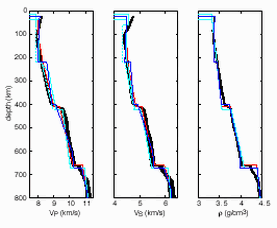
| Home |
| Research |
| Publications |
| CV |
| Personal |
| Seismo Lab |
| Earth & Planetary |
| UC Berkeley |
| Physical
Reference Models
- One-dimensional seismic reference models are known to be a non-unique
solution to global seismic data, hampering an interpretation in terms
of physical structure. Physical models that fit seismic data well
enough to be useful as a seismic reference model can significantly
facilitate physical interpretation of seismic structures. The PREF models are obtained
by assuming pyrolite composition (with
phase transitions) and adiabatic thermal structure (potential
temperature at 1300°C) below lithosphere. Above the lithosphere,
geotherm for a 60 my old ocean is taken.
Mineral physics parameters of these models have been varied within their uncertainties in order to fit global seismic data. 99 PREF models for the upper mantle show a satisfactorily fit to global seismic data which are sensitive to the upper mantle, i.e. travel times with epicentral distance between 18.5°-26°, normal mode frequencies with angular order > 60°. |
 |
| However, adiabatic
pyrolite have problems to (1) fit the average upper
mantle and lower antle travel time residuals simultaneously, and (2)
produce the low velocity depth gradient that teleseismic travel times
require in the lower mantle. In Berkeley, I have investigated the average physical structure of the upper mantle by using long period waveform data and using NACT theory. With Laura Cobden and Saskia Goes (Imperial College, London), we have investigated the nature of the average structure by assessing the several sources of uncertainties and including SS arrival times. In general, we found that a compositional stratification is required to explain seismic data (see PNAS paper (2007). and Laura's one (GJI 2008)). For the lower mantle, the thermo-chemical interpretation of one-dimensional seismic reference models is affected by the large uncertainties in material properties at high pressure and temperature. We use a statistical approach that account for these uncertainties and the seismic ones. The role of using different EOS (Mie-Gruneisen vs 3rd order Birch-Murnaghan) is also considered. USING THE MODELS? Download PREF upper mantle models (Cammarano et al., 2005) KNOWING MORE? Download recent papers and posters |
 |
